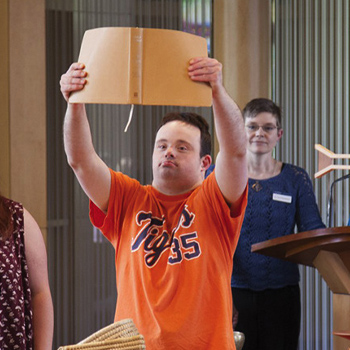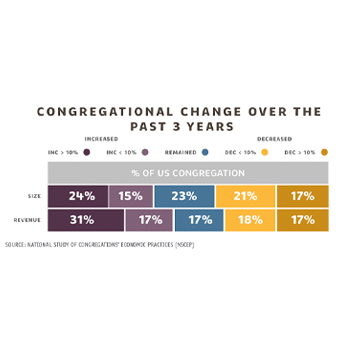
Student debt figures are numbing, with consequences that will extend far into the future. Educational borrowing has increased exorbitantly over the past few decades — not surprising considering the rising cost of tuition and the easy availability of loans. Yet salaries, particularly in ministry and academia, haven’t kept pace, making loan repayment a long process and a heavy burden for many seminary students.
Consider these sobering statistics:
- The current student loan debt in the United States is $1.6 trillion.
- One in six American adults has educational debt.
- The average debt incurred by students to fund their seminary education is $33,000.
Debt affects the quality of life of students and their ability to answer calls to ministry. To address it effectively, I believe we need to take into consideration and understand all aspects of student debt: the undergraduate debt that students bring with them to seminary, the additional debt they take on while in seminary, and the debt they will continue to incur throughout their lives.
Not everyone agrees with me. Many of the seminary board members surveyed by the In Trust Center in 2019 view student debt primarily as an issue related to the high cost of tuition, and they don’t readily recognize that its impact extends far beyond just their own institutions. (For more, see “Survey Reveals a Need for More Data on Student Debt”.)
To understand where we currently are in the student debt dilemma, it’s helpful to revisit important research findings from the last 25 years. In the 1990s, the Center for the Study of Theological Education at Auburn Seminary published Manna from Heaven, a report on the findings of a four-year national study on student indebtedness. It reported that while indebtedness was not yet a major problem, debt levels were rising steeply and might become a significant issue down the road. The study also questioned the value of large loan funds and suggested that student debt would most likely have a negative impact on graduates’ futures, their calls to ministry, and their choices of assignments.
A decade later, in 2005, a second Auburn report on student debt, The Gathering Storm, exposed alarming news about indebtedness: not only had the number of theological students with debt increased, but the average amount of that debt had escalated dramatically.
This trend continued for another 10 years, and when the third Auburn debt report, Taming the Tempest, was published in 2014, it confirmed that students from virtually all schools were touched by debt, and the amount of their debt had reached levels that were destabilizing the financial futures of students.
As financial consultant Anthony Ruger points out, the federal student aid program of the 1960s was not intended for, nor did it work well for, students who planned to become clergy. Ruger, who was a co-author of all three Auburn reports, agrees with the established wisdom that the loan program was established to give students access — access to educational opportunities that would qualify them for high-paying jobs after graduation.
But having a theological education has rarely boosted the salaries of its graduates, and ministry has never paid seminary graduates at levels commensurate with their education. As one participant in the 2005 Auburn study said, “I couldn’t even think about taking a job in ministry once my student loans came due.” Another seminary graduate described student debt as “the silent clergy killer.”
Servicing the debt
“Why Student Loans Are Different,” a 2015 report from the think tank, New America, makes the case that student loans can be harder to understand than other types of loans. Unlike car loans where buyers are told the exact length of the loan and the exact amount of the payments, education loans are often open-ended, imprecise, and changeable. Student borrowers tend to focus on the loan principal as opposed to the pay-back amount, ignoring the interest that builds while they attend school. Shock sets in when they realize the amount of their debt. And if they need an extra semester or two to complete their degrees, the numbers become even more sobering.
For example, if a student borrows $33,000 (the current average for seminary borrowers) and accepts a job that pays $40,000 a year, that student will pay approximately 14 percent of his or her salary to service the loan. That means take-home pay will be about $2,600 a month. However, if he or she is also carrying a similar amount of undergraduate debt, the debt service obligation will of course be doubled.
When you factor in data from the Bureau of Labor Statistics, whose recent Consumer Expenditure Survey says average consumers spend about 33 percent of their total annual income on housing, it quickly becomes obvious that spending 15 to 30 percent to service a student debt while paying a mortgage can be nearly impossible, with little left for other expenses.
Despite this grim picture, even financially astute students still tend to view student debt as “good” debt; they see it as a means to an end, “an investment in my future.” They give little consideration to the long-term impact debt can have on all aspects of life — on their parents, spouses, children, the congregations or organizations they hope to serve, the communities in which they hope to live, and even the impact on the overall economy. They assume a degree will bring them financial security and ensure their ability to pay off their loans. But returns on higher education aren’t what they once were.
A domino effect
Several research organizations that have studied the impact of student debt have noted that debt sets off a domino effect, the most obvious of which is that debt begets debt. Repaying a student loan is only one of many obligations — borrowers with student debt also juggle home mortgages, car payments, and credit card bills.
Those with crushing debt experience a host of negative consequences. Publications like the Washington Post, USA Today, and Forbes have reported the following kinds of problems.
Stress and illness
Worrying about debt repayment takes its toll on a borrower’s physical, emotional, and mental health. One in three respondents to a 2018 national study reported that their student loan debt was a major source of stress.1 Another survey reported that 39 percent of respondents ages 25 to 45 said their financial stress was having a negative impact on their health, 35 percent said it was damaging their relationship with a spouse or significant other, and 26 percent said it was affecting their performance at work.2
A 2015 Gallup poll found that Americans who graduated from college between 1990 and 2014 and who had borrowed $50,000 or more were less likely to thrive physically, emotionally, or financially than their debt-free peers.3 The Gallup poll results mirror those of a Lending Tree poll in which 65 percent of respondents claimed to have lost sleep worrying about their student debt, and 70 percent reported having physical symptoms ranging from headaches and fatigue to muscle tension and shortness of breath.4
Delay of marriage and family
The financial advantages of marriage — for both women and men, but particularly for men — has been widely reported. Yet according to the Pew Research Center, the median age for marriage is now 27 for women and 29 for men, while in 1960 it was 20 and 23, respectively.5 The odds of a woman marrying in the first four years after graduating from college decrease by 2 percent per month for every $1,000 of student debt she incurs. Furthermore, because women attend college at higher rates than men and because they are more likely than men to pursue graduate degrees, they leave school with more debt: 42 percent of women — and only 27 percent of men — have more than $30,000 in college debt. Women earn less than men, so loan repayment can be more challenging for them.6
Once married, those with student loan debt start their families later and have fewer children. Roughly one in five Americans with student loans say their debt has had a negative effect on their ability to provide or pay for child care, according to a report by the Massachusetts Institute of Technology’s AgeLab.7
Deferment of dreams
In 2015, the research department of the Federal Reserve Bank of Philadelphia reported a significant and economically meaningful negative correlation between student loan debt and small business formation.8 Another study found that 39 percent of the people surveyed said debt prevented them from achieving their career goals, and 28 percent said debt was negatively affecting their plans to start a business.9 In 2019, author Mark Travers expressed it more bluntly in the title of a Forbes article: “The Student Debt Crisis Is Crushing Entrepreneurship” — something that has always been a strong and reliable engine of economic growth and employment.
The implications for seminary students — including graduates and those who leave school before getting a degree — are obvious. The burden of repaying education loans can discourage dreams — dreams, for example, of doing missionary work in another country, of accepting a call to plant a church, or of starting a community nonprofit organization. Students with heavy debt loads are less choosy — more inclined to accept part-time jobs with limited career potential. Moreover, debt impedes the ability to do charitable work and to give generously to the charitable works of others.
Delay of homeownership
Student loan debt is taking a bite out of the housing market. In fact, the median age of homebuyers in the United States is currently 46, the oldest since 1981 when records began to be kept. Today, approximately 40 percent of Americans between the ages of 25 and 34 own homes, whereas in 2001, it was 48 percent. One of the many factors contributing to this trend is that the cost of homes has risen 21 percent since 2000, but in the same period, household income has increased by only 2 percent.10 A 2018 study found that for 30 percent of borrowers, their monthly loan payments were higher than their monthly rent or mortgage. Participants in this study also reported having less than $1,000 in savings, which hardly qualifies as a down payment on a home. The domino effect of debt is evident.11
Recently the Urban Institute reported that among people who turned 60 between the years of 2003 and 2015, those who had bought their first home when they were between the ages of 25 and 34 had a current median household net worth that was twice as much as those who waited until after 35. Yet late homebuyers do not make up for the lack of home equity with other wealth-building savings. According to projections based on federal statistics, the median net worth of homeowners is now around $230,000, while for renters it is only about $5,000.12
Delay of retirement savings
Student loan debt makes it hard for young people to establish a rainy day fund or save for retirement. More than 80 percent of respondents to a 2018 survey said their loan obligation was the reason they weren’t preparing adequately for their golden years.13 Moreover, the impact is generational. Parents and grandparents who take out loans, either to return to school themselves or to ease the burden of debt on family members, often put their savings plans on hold. Since 2004, the student loan debt held by people who are 60 and older has grown faster than for any other age group. The families headed by someone 50 or older with student loan debt more than tripled between 1989 and 2016, according to the AARP Public Policy Institute.14
Unfinished business
The good news is that many theological schools and those who govern them are taking meaningful steps to address the growing student debt problem. Some schools have decided not to permit their students to take out federal loans. Many schools are offering financial literacy training to their students and graduates. Financial aid advisors are counseling seminary applicants about the impact debt can have on their lives, their families, and the communities they serve, while underscoring the lifetime benefits of education and society’s need for the critical work of seminary graduates.
As we celebrate how far we have come in recognizing the problem, we need to acknowledge that much work remains to be done.
A gathering on economic challenges
In November 2019, the Association of Theological Schools (ATS) hosted a gathering of 200 seminary leaders in Pittsburgh to celebrate and discuss the impact of the Economic Challenges Facing Future Ministers initiative (ECFFM). Staff from the In Trust Center took part in the event, and Amy Kardash, president of the In Trust Center, gave a presentation to some of the assembled presidents and board members about the impact of student debt. The event was funded by Lilly Endowment Inc.
This article is an abridged version of Kardash’s presentation. To request a copy of full presentation, email resources@intrust.org.
Eight questions for theological school boards
As boards and senior leaders of theological schools consider how to help students navigate the complex issues surrounding debt, here are some questions they may want to discuss:
- Should all applicants, regardless of the level of their debt, be able to attend our school?
- Whose role is it to determine if students are borrowing beyond their means?
- What is a school’s responsibility for sharing the realities of ministerial salaries?
- Should we offer financial counseling to students before they have accumulated debt or closer to graduation?
- In what ways are we compromising our mission if students graduate with unsustainable levels of debt?
- Who determines what levels of student debt are acceptable or unacceptable?
- How do we respond to the belief that debt is solely a student’s issue and not a school’s concern?
- How can we balance our concern for the financial health of students with our institutional reliance on revenue from tuition?
Survey reveals need for more data on student debt
The In Trust Center for Theological Schools and the Association of Theological Schools (ATS) surveyed seminary trustees to learn how student debt conversations affect their work. Here’s what we learned from more than 300 respondents.
- More than 70 percent were unaware of the Economic Challenges Facing Future Ministers initiative (ECFFM) coordinated by ATS.
- More than half were either “extremely concerned” or “very concerned” about students taking on too much educational debt, and the remaining 43 percent were less concerned.
- Just under half said student debt is a “significant consideration” when discussing changes to tuition and programs, and 50 percent said it is a “moderate consideration” or “not a consideration.”
- The majority of respondents said they learned about student debt through board reports and in board discussions.
- Many said they would welcome more data about undergraduate debt, the impact of debt on students, and information comparing the debt levels of different schools.
- Many attributed the problem of student debt primarily to the increased cost of tuition.
- Many reported needing to balance concerns for the survival of their schools with concerns about student debt.
In general, respondents felt they had insufficient information about how much debt students bring from their undergraduate education, how much debt they incur while in seminary, and the impact of that debt beyond their own institutions.
On the positive side, many school leaders and their boards described ways they are addressing student debt. These actions include raising money for scholarships, discussing finances with prospective students during the admissions process, reviewing financial aid and scholarship policies, and conducting research on student debt.
For more information about the board survey, email resources@intrust.org. To learn about the ECFFM initiative, visit www.ats.edu.
Sources
5. www.cnbc.com
10. www.wsj.com
12. www.urban.org; www.forbes.com
14. www.aarp.org




























